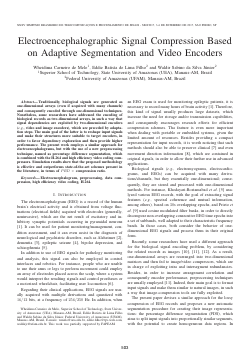
Electroencephalographic Signal Compression Based on Adaptive Segmentation and Video Encoders
Wheidima Carneiro de Melo, Eddie Batista de Lima Filho, Waldir Sabino da Silva Junior
DOI: 10.14209/sbrt.2017.228
Evento: XXXV Simpósio Brasileiro de Telecomunicações e Processamento de Sinais (SBrT2017)
Keywords: Electroencephalogram preprocessing data com- pression high efficiency video coding H.264
Abstract
Traditionally, biological signals are generated as one-dimensional arrays (even if acquired with many channels) and consequently encoded through one-dimensional techniques. Nonetheless, some researchers have addressed the encoding of biological records as two-dimensional arrays, in such a way that signal dependencies are exploited by two-dimensional encoders (e.g., video and image encoders), which are preceded by adapta- tion steps. The main goal of the latter is to reshape input signals and make their structures more suitable to target encoders, in order to favor dependency exploration and then provide higher performance. The present work employs a similar approach for electroencephalograms, but with the use of a new preprocessing technique, named as percentage difference segmentation, which is combined with the H.264 and high efficiency video coding com- pressors. Simulation results show that the proposed methodology is effective and outperforms state-of-the-art schemes present in the literature, in terms of P RD × compression ratio.Download